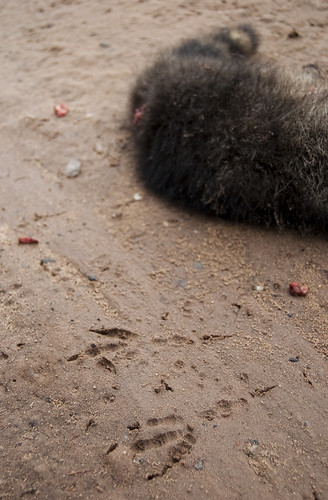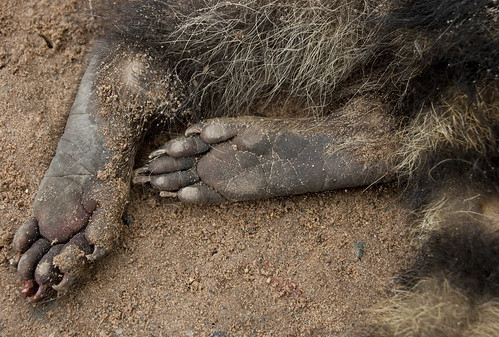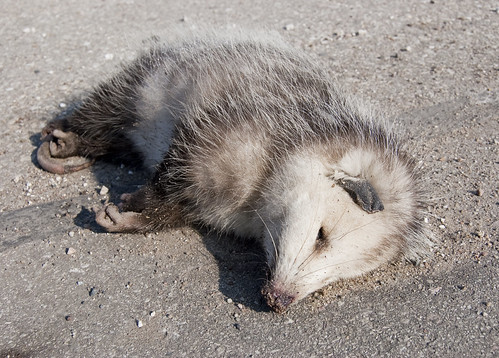 Two days ago, on a drive along Highway 550 (the Big Bay Highway), Steph and I spotted a raccoon on the side of the road. It was a small animal, much smaller than most raccoons I've seen; its head was crushed, and there were many raven tracks all around the scene. The scavengers had already started to pick away at the body.
Two days ago, on a drive along Highway 550 (the Big Bay Highway), Steph and I spotted a raccoon on the side of the road. It was a small animal, much smaller than most raccoons I've seen; its head was crushed, and there were many raven tracks all around the scene. The scavengers had already started to pick away at the body. Of course, I photographed the raccoon's feet. Animal feet are pretty amazing, and they're all so very different from species to species. How often is it that you get to see a raccoon foot, anyway? My mother posed an interesting question: are raccoon "finger" prints all unique, as they are with humans? I'm willing to bet they are.
Of course, I photographed the raccoon's feet. Animal feet are pretty amazing, and they're all so very different from species to species. How often is it that you get to see a raccoon foot, anyway? My mother posed an interesting question: are raccoon "finger" prints all unique, as they are with humans? I'm willing to bet they are.Today, Steph and I drove south on Highway 41 to Menominee (and then backtracked a bit because we missed our turn to get to the DeYoung Family Zoo). We saw plenty of evidence of dead animals along the road; I counted two deer and two porcupines, as well as three or four raccoons and a squirrel, and what was perhaps a fox. One of the first dead critters Steph and I spotted, though, was an opossum, near Escanaba.
Opossums aren't generally found in the Upper Peninsula; they're ill-adapted to the region's chilly winter climate. However, they do roam in the southernmost parts of the U.P., and somehow they are able to survive the cold and snow. Highways, though, are another threat. The individual we found was not a very big animal.
 If you examine the photograph closely, you can see that the skin is stripped from the bone at the end of the tail. Did this happen when the opossum was struck by a car, or did it get frostbite? I've heard of opossums getting frostbite on their naked fingers, tails, and noses, but I'm not so sure about this. The 'possum seemed pretty healthy and hadn't been dead for long:
If you examine the photograph closely, you can see that the skin is stripped from the bone at the end of the tail. Did this happen when the opossum was struck by a car, or did it get frostbite? I've heard of opossums getting frostbite on their naked fingers, tails, and noses, but I'm not so sure about this. The 'possum seemed pretty healthy and hadn't been dead for long: Opossums are pretty animals, in my opinion. They're quite bizarre, too, being North America's only marsupial.
Opossums are pretty animals, in my opinion. They're quite bizarre, too, being North America's only marsupial.With the warmer temperatures also comes the melting of snowbanks. What's left behind along the highway often seems to consist of cigarette butts, car parts, and old roadkill. One of the porcupines I saw today had been frozen for a long time, and was finally escaping -- for the time being -- from its snowbank tomb. The animal was rather indistinguishable; I think I might have seen its head, and maybe one of its arms, but it was pretty hard to tell what was what. I did, however, take a photograph of the quills on its tail:
 With all the dead animals we saw strewn along the roadside today, it goes without saying we saw many winged scavengers: crows, ravens, and bald eagles, all feasting on the bodies, making sure that nothing is wasted in nature.
With all the dead animals we saw strewn along the roadside today, it goes without saying we saw many winged scavengers: crows, ravens, and bald eagles, all feasting on the bodies, making sure that nothing is wasted in nature.




No comments:
Post a Comment